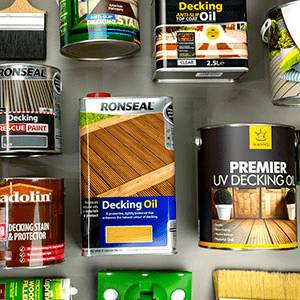Furniture Finish FAQ's
What can I put on my antique furniture to revive it?
We recommend using a wax as it can be applied over previous wax, and oil finishes. This removes the need to sand back to bare wood, removing the wood's natural patina. We recommend trying Fiddes Supreme Wax Polish or an alternative furniture wax to revive your furniture
What paint can I use to produce a Shabby Chic finish on furniture?
The Shabby Chic look can be easily achieved with a wide range of paint types including emulsion paint, clay paint and chalk paint. We supply a range of clay paint products from Earthborn which are ideal and environmentally friendly. Ronseal also offer a Chalky Furniture Paint that is perfect for Shabby Chic projects.
Whilst emulsion paints can be used we recommend chalk or clay paints becuase they are easy to rub down, allowing the wood or coating below the paint to show through.
Can you advise on how to strip wood furniture?
Before attempting to strip a piece of wood furniture it's important to know what type of finish you are removing. Old coats of wax should be removed using a Wax and Polish Remover, oil finishes can be removed by scrubbing the wood with white spirit whilst layers of paint and varnish will require a paint stripper. See our full range of paint strippers and removers suitable for wooden furniture.
Which product is best for a freshly sanded Pine kitchen table top?
If you are looking to retain the appearance of the wood grain rather than painting it, we recommend using a clear wood oil or varnish. Varnishes tend to offer better durability whereas wood oils are easier to patch repair and maintain if they become stained, scratched or worn. Pine can turn an orange or yellow shade when over-coated with a 'clear' product, there are however oil based products such as Osmo Polyx Oil Raw (3044) and Fiddes Hard Wax Oil Natural that counteract this and help to retain the freshly sanded or unfinished appearance on light coloured woods.
How can I tell what type of wood finish is on my furniture?
Knowing what type of wood finish a piece of furniture has may not always be obvious. For example, matt varnish can look like a wax or oil finish whereas a gloss oil or a highly buffed wax finish may look like a varnish.
One simple test is to lightly scrape the surface of the wood with a finger nail or the edge of a coin in an inconspicuous area, such as the underside of a table or chair or near the bottom, inside edge of a leg. If the furniture has been waxed, small traces of the wax will easily come away when scraped.
Another test is to lightly dampen a 'white' cloth with white spirit and gently rub an inconspicuous area. If the furniture has been oiled, the white spirit will remove some of the oil, making it visible on the cloth.
If neither of the above methods remove any finish, it's pretty much safe to say that the furniture has been varnished.
Can surface scratches and gouges on a dining table top be repaired?
Knowing how to repair surface scratches and gouges on a table top depends on how bad they are and the type of finish on the table i.e. an oil, wax, varnish or paint. If the table top is painted, the best approach is to sand the table top back to bare wood, fill any gouges and deep scratches with a suitable wood filler, re sand the repaired areas for a smooth surface, then re-paint.
For varnished and waxed furniture a range of repair crayons, pens and wax filler sticks can be used to repair or lessen the impact of scratches and gouges. If the damage is particularly bad, the only option may be to sand the table top back to bare wood and re-finish with a clear or coloured interior varnish that is suitable and durable enough for table tops.
Table tops that have been oiled or waxed are by far the easiest to repair. In most cases the table top simply needs a light sanding then re-oiling or waxing to restore the finish once any deeper gouges have been filled. Take care to remove all traces of sanding dust prior to oiling or waxing to prevent dust getting stuck in the finish. To strip a build-up of old wax coatings, a wax and polish remover is more effective than sanding alone.
Hi. Wondered if you could give me a few pointers, I'm a metal fabricator by trade and have been asked by a few people (family members) if I could make them a coffee table. Will be about 1000mm X 600mm. I've got some new scaffold boards which I'm planning on using, I've got a sander and can get it cut to size, but don't really know about how to finish it, which products to use. Also will need a wood glue to help make the right size. Could you please give me some info on what would be the best products to use, not so much colour as that will be up to whoever is having the table.
It's worth mentioning that whilst scaffold boards are widely used for furniture, they can be prone to shrinkage and warping. It's probably best to buy new boards that have been kiln dried and allowed to acclimatise to normal room conditions in terms of temperature and humidity, before planning to achieve a consistent thickness and size. For the best finish, they should be sanded with a 120 to 150 grit abrasive. Sanding too finely can cause issues with any wood finish that you choose to use.
A popular choice of finish for interior wood is hard wax oils. Hard wax oil products are durable, hard wearing, liquid, dirt and heat resistant. They are available in both clear and coloured formulations, are easy to apply, maintain and patch repair if required. Hard wax oils are ideal for use on wooden furniture, floors, doors and kitchen worktops. When finishing the wood treat all sides including the edges and ends as this will help to prevent the wood from drying out.
In terms of glues, we can recommend the following...
We have a new settee made from kiln dried pine. We need to finish it and want to darken the shade a bit to fit in with our other furniture, whilst avoiding that Orange wood look.
To help avoid the orange look of pine we often recommend Fiddes Hard Wax Oil Natural or Osmo Polyx Oil Raw (3044). These are penetrating wood oils that contain a small amount of white pigment. This pigment counteracts the darkening and colour enhancement that is usually associated with clear wood finishing products on lighter coloured woods such as Pine. This product will better retain the natural, untreated look of the wood, whilst giving a durable, water and dirt resistant finish. Although it contains a small amount of white, it will not turn the wood visibly white if applied correctly i.e. 2 thin coats and wiping off any excess.
A clear hard wax oil or wood varnish will give a darker, almost damp like appearance but will likely enhance the naturally golden / orange character of the pine. A good way to test how the wood will look with a clear coat is to slightly dampen the wood with a clean sponge and water. This will give an indication of how the wood might look with a clear wood oil or varnish. This will of course vanish as the damp area dries out.
We always recommend doing test areas in an inconspicuous area such as the underside or inside of furniture to assess any product, it's suitability and final finish. Sample sizes of these products are available on our website.
Advice needed on how to treat woodworm in furniture
Unfinished furniture should be treated with a woodworm killer such as Barrettine Premier Woodworm Killer or Ronseal Woodworm Killer. The Furniture can then be treated with a suitable Interior wood preservative to help prevent future infestation.
Furniture that has been painted, waxed, varnished or oiled should be stripped back to bare wood before treating with a woodworm killer. This is to ensure that the woodworm treatment reaches all areas to kill any active woodworm or larvae. The furniture can then treated with an interior wood preservative and then refinished with your choice of wood finish.
Hi, I've got a off-cut from our oak kitchen worktop that I'd like to use for a desk top. I want to stain it darker and was thinking of using Morrells Light Fast Wood Stain. Can I use any solvent based polyurethane varnish like Dulux Trade Polyurethane Varnish? And should I apply a 50/50 thinned sanding sealer like Barrettine Shellac Sanding Sealer before staining?
Morrells Light Fast Wood Stain will be ideal for your work top / desk top project. The surface should be sanded to no finer than 120 to 150 grit and wiped clean with methylated spirit and allowed to dry prior to staining.
Once stained, the wood will be ready for varnishing and any polyurethane varnish will be fine. If using a solvent-based varnish, take care when applying the first coat. Apply the varnish gently and with minimal brush strokes to avoid re-activating the stain and dragging the colour. Once the first coat is dry, the second coat will be fine as the stain would have been sealed into the wood by the dry first coat.
When staining then finishing wood, It is vital to carry out a test area with both the stain and varnish top-coat. The top-coat will enhance the colour and depth of the stain and can look very different to just the stain alone.
hello we have sanded down iroko worktops in our science labs and would like to know what is the best product to seal the surface
For a domestic Iroko worktop we would normally recommend a thin oil such as Osmo Wood Wax Finish Extra Thin (1101). However, whilst this product is durable, easy to maintain and repair, it probably won't stand up to the demands of a school science table.
The preferred alternative would be a durable, commercial grade varnish such as Sadolin PV67 Heavy Duty Varnish or Manns Trade Bar Top Lacquer which will provide an ultra tough and durable finish.
Before applying either of the above, it's essential that the work top surface is prepared by sanding then wiped down with methylated spirit. Iroko is a naturally oily wood and any oil in or near the surface must be dissolved and removed prior to applying the varnish. An isolating wood primer may also help with adhesion. Once sanded and wiped down with meths, the work top should be lacquered fairly quickly so that deeper oil in the wood doesn't have a chance to raise to the surface.
Related furniture finishing blog posts
- Hardwood v Softwood Furniture and Decking
- Join The Vintage Retro Furniture Revival - Recycle To Recreate
- How to Shabby Chic Furniture for a Stunning Contemporary Look
- Your Wooden Garden Furniture Can Outlive You - Here's How
Disclaimer: Whilst every attempt has been made to provide product information that is as accurate as possible, it's important to clarify that trees and the wood that they produce can be affected by many factors. For example, the same species of tree grown in the same wood, even in close proximity, will be affected by age along with the amount of sunlight and water they receive. Other naturally occurring biological and environmental factors will also influence the density and grain of the wood as well as the moisture and oil content of the timber. No two trees are the same, meaning each piece of wood has the potential to look and react differently to the same wood finish. For example, product adhesion, colour variations, absorption rates and sheen levels. It is for this reason that we always strongly recommend carrying out test areas before starting any project


